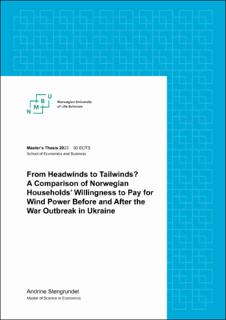| dc.contributor.advisor | Anders Dugstad | |
| dc.contributor.advisor | Abinet Tilahun Aweke | |
| dc.contributor.author | Stengrundet, Andrine | |
| dc.date.accessioned | 2023-07-06T16:28:10Z | |
| dc.date.available | 2023-07-06T16:28:10Z | |
| dc.date.issued | 2023 | |
| dc.identifier | no.nmbu:wiseflow:6839527:54591760 | |
| dc.identifier.uri | https://hdl.handle.net/11250/3076773 | |
| dc.description.abstract | This paper is a contribution to the discussion of stability of preferences and willingness to payestimates measured through nonmarket valuation. Such estimates are used by researchers
conducting cost-benefit analyses of various policies, and their findings are often used by decision
makers. The estimates thereby play an important part in discussions of policy implementations,
which emphasizes that they should be valid and representative for the population in question.
This thesis tests how sensitive estimated preferences are when exogenous shocks occur, to give an
indication of their stability. The exogenous shock considered is the war outbreak in Ukraine, which
led to an insecure energy supply, rocketing energy prices and overall energy uncertainty. The data
consists of a pilot and main survey sample of a discrete choice experiment survey mapping
Norwegian households’ attitudes towards land-based wind power. By using logit models, mean
willingness to pay-estimates are measured for both survey samples. After comparing the estimates
and checking for a statistically significant difference, a conclusion is drawn of whether the
willingness to pay-estimates are stable when exogenous shocks, such as the war outbreak, occur.
The findings indicate that the main survey sample is less positive to increased renewable energy
than the pilot, yet more accepting of installation of new land-based wind turbines. Moreover, the
results indicate that this difference between the pilot and main survey sample is statistically
significant. This implies that estimated preferences are sensitive to exogenous shocks and should
be used with caution. However, the difference could be explained through survey alterations
between the piloting and main survey. Furthermore, the significant difference in mean willingness
to pay could be a shock response to the war outbreak rather than a change in Norwegian
households’ underlying preferences. Doing a re-testing of the main survey and checking for
statistical difference to the initial main survey could aid in determining if the preferences did
indeed change, which would strengthen the results found in this study. | |
| dc.description.abstract | This paper is a contribution to the discussion of stability of preferences and willingness to payestimates measured through nonmarket valuation. Such estimates are used by researchers
conducting cost-benefit analyses of various policies, and their findings are often used by decision
makers. The estimates thereby play an important part in discussions of policy implementations,
which emphasizes that they should be valid and representative for the population in question.
This thesis tests how sensitive estimated preferences are when exogenous shocks occur, to give an
indication of their stability. The exogenous shock considered is the war outbreak in Ukraine, which
led to an insecure energy supply, rocketing energy prices and overall energy uncertainty. The data
consists of a pilot and main survey sample of a discrete choice experiment survey mapping
Norwegian households’ attitudes towards land-based wind power. By using logit models, mean
willingness to pay-estimates are measured for both survey samples. After comparing the estimates
and checking for a statistically significant difference, a conclusion is drawn of whether the
willingness to pay-estimates are stable when exogenous shocks, such as the war outbreak, occur.
The findings indicate that the main survey sample is less positive to increased renewable energy
than the pilot, yet more accepting of installation of new land-based wind turbines. Moreover, the
results indicate that this difference between the pilot and main survey sample is statistically
significant. This implies that estimated preferences are sensitive to exogenous shocks and should
be used with caution. However, the difference could be explained through survey alterations
between the piloting and main survey. Furthermore, the significant difference in mean willingness
to pay could be a shock response to the war outbreak rather than a change in Norwegian
households’ underlying preferences. Doing a re-testing of the main survey and checking for
statistical difference to the initial main survey could aid in determining if the preferences did
indeed change, which would strengthen the results found in this study. | |
| dc.language | eng | |
| dc.publisher | Norwegian University of Life Sciences | |
| dc.title | From Headwinds to Tailwinds? A Comparison of Norwegian Households’ Willingness to Pay for Wind Power Before and After the War Outbreak in Ukraine | |
| dc.type | Master thesis | |
